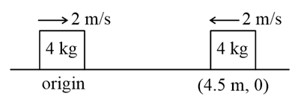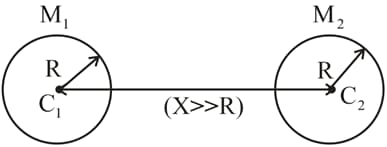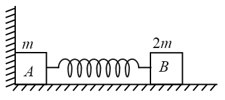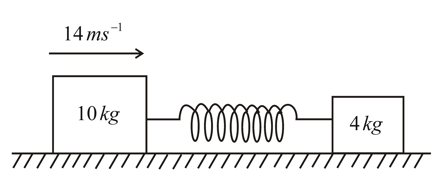Motion of Center of Mass
Motion of Center of Mass: Overview
This topic covers concepts, such as Velocity of Centre of Mass, Acceleration of Centre of Mass & Explosion of a Projectile in Its Path etc.
Important Questions on Motion of Center of Mass
Two bodies of and are moving with velocities and respectively towards each other under mutual gravitational attraction. Find the velocity of their centre of mass in .
In free space, a shell moving with velocity along the positive -axis. When it passes through origin, it explodes into two peices of mass ratio . After the explosion, the velocity of the centre of mass is :-
Two bodies of different masses and are moving with velocities and towards each other due to mutual gravitational attraction. Then the velocity of the centre of mass is
Two bodies of masses and are moving with velocity and respectively. The velocity of the centre of mass will be
Blocks and are resting on a smooth horizontal surface given equal speeds of in opposite sense as shown in the figure.

At the position of blocks are shown, then the co-ordinates of center of mass at will be :-
When an explosive shell travelling in a parabolic path under the effect of gravity explodes in the mid air, the centre of mass of the fragments will move:-
If particles moves under mutual gravitational attraction force then find the ratio of their acceleration just after releasing from rest:-

A small ball is moving inside a box which is placed on a smooth horizontal surface. During motion, the ball makes collisions with the walls of the box then the position of the centre of mass:
Find the linear momentum of a disc having mass and radius revolving around the central axis by .
Which of the following is possible if a non-zero external force acts on a system of particles while at a particular time the velocity and acceleration of the center of mass are found to be and .
If the external forces acting on a system have zero resultant, the centre of mass
Two blocks A and B of mass m and 2m respectively are connected together by a light spring of stiffness K and natural length . The system is lying on a smooth horizontal surface with the block A in contact with a fixed vertical wall as shown in the figure. The block B is pressed towards the wall by a distance from the natural position of spring and then released. There is no friction anywhere.

If block B is released at time and A just loses contact with the wall at time then the average acceleration of the centre of mass of the system during the time to is:
Two particles of equal mass have velocities and . First particle has an acceleration while the acceleration of the other particle is zero. The centre of mass of the two particles moves in a path of
Two particles and (both initially at rest) start moving towards each other under a mutual force of attraction. At the instant, when the speed of is and the speed of is the speed of the centre of mass is
A bomb of mass 1 kg is thrown vertically upwards with a speed of . After 5 seconds it explodes into two fragments. One fragment of mass 400 gm is found to go down with a speed of . What will happen to the second fragment just after the explosion?
Two bodies A and B of masses and respectively are connected by a massless spring of force constant k. A constant force F starts acting on the body A at . Then

A solid cylinder of mass m and radius R rolls down an inclined plane of height h without slipping. The speed of its centre of mass when it reaches the bottom is
Two bodies of and masses have their velocity (in ) and respectively. Then the velocity of their centre of mass (in ) is
A loaded spring gun of mass fires a shot of mass with a velocity at an angle of elevation . The gun was initially at rest on a horizontal frictionless surface. After firing, the centre of mass of gun-shot system:
Two blocks of masses and are connected by a spring of negligible mass and placed on a frictionless horizontal surface. An impulsive force gives a velocity of to the heavier block in the direction of the lighter block. The velocity of the centre of mass of the system at that very moment is

